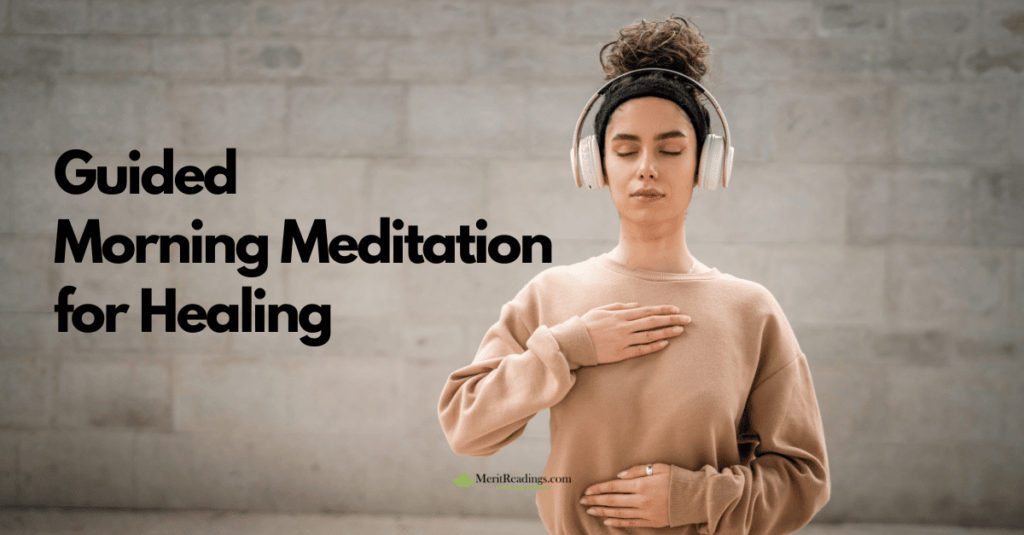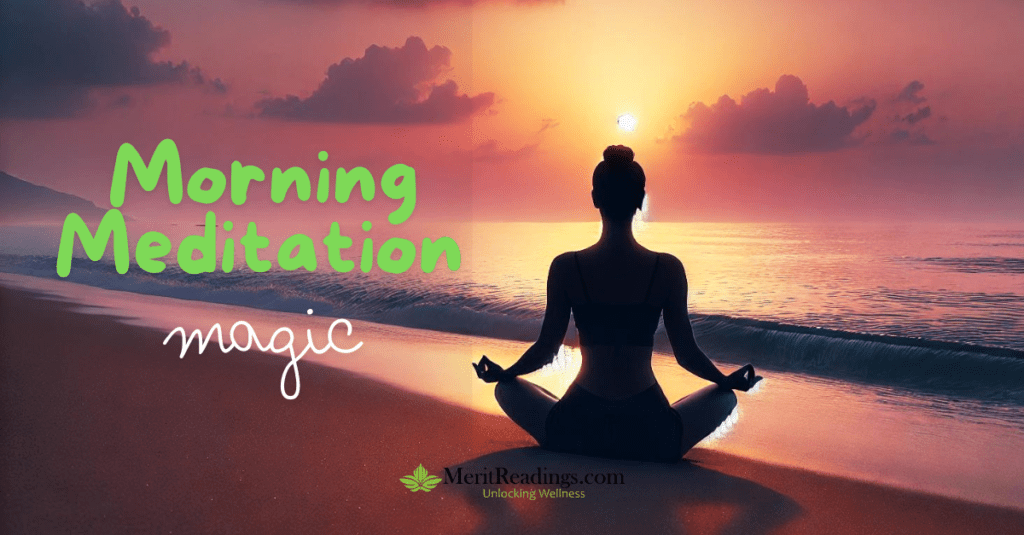Starting the day with a bit of calm makes a big difference. We all carry stress, often without noticing, and a few minutes of healing meditation helps you feel lighter and more focused. It’s not just about feeling good – research shows that morning meditation can actually reduce stress hormones by up to 20% and help you stay focused for hours afterward.
Think of it as giving yourself a mental tune-up each morning. Whether you’re looking for mental clarity, stress relief, or just a steady, calm start, these meditation practices are here to support you. Don’t worry if you’re new to this – we’ll explore different techniques that are easy to follow and backed by science.
In this guide, we’ll examine various morning meditation practices that can help you feel more balanced and ready for your day. I’ll share both the practical experience and the research behind why these techniques work so you can understand how they’re helping you while you practice them.
- What is Guided Morning Meditation?
- Key Differentiators from Regular Meditation
- Types of Guided Morning Meditation for Healing
- What Are the Benefits of Guided Morning Meditation for Healing?
- Tools and Apps to Help with Guided Morning Meditation
- Tips for Making Guided Morning Meditation a Daily Habit
- Conclusion
- Next Steps
- FAQs
What is Guided Morning Meditation?

Guided morning meditation is a structured mindfulness practice that combines expert instruction with morning-oriented techniques. It differs from traditional meditation in several key ways:
Technical Elements
- Instructor-led progression (live or recorded)
- Timed breathing exercises and body scanning
- Specific visualization sequences
- Progressive relaxation techniques
- Morning-specific energy alignment
Key Differentiators from Regular Meditation
| Aspect | Guided Morning Meditation | Regular Meditation |
| Structure | Ideal for beginners provides clear direction. | Self-directed; relies on personal focus and awareness. |
| Level of Guidance | High—clear prompts and instructions to follow. | Low—relies on personal guidance or none at all. |
| Suitability for Beginners | Ideal for beginners, provides clear direction. | May be challenging for beginners without prior experience. |
| Focus | Often focuses on specific themes (e.g., stress relief, positivity). | General focus, can vary by the practitioner’s intention. |
| Mental State | Helps ease distractions and wandering thoughts. | May lead to more wandering thoughts, especially for beginners. |
| Duration | Typically shorter, around 10–20 minutes. | Can vary greatly in length, depending on personal preference. |
| Goal | Provides structure for achieving specific emotional or physical goals (e.g., healing, clarity). | Often aims for a general state of mindfulness or awareness. |
This comparison should help you better understand how each type of meditation works and which one might be best for your needs.
Types of Guided Morning Meditation for Healing
Here are some specific types of guided morning meditations that are effective for healing:
1. Sun Salutation Morning Meditation(15 minutes):
This combines guided meditation with a sequence of yoga poses known as the Sun Salutation. As you move through each pose, you coordinate with your breath, improves mind-body connection that boosts flexibility, strength, and mental clarity.
2. Walking Morning Meditation:
If you find it hard to sit still, walking meditation is a great option. It involves focusing on each step you take and your breath as you move. Whether you’re inside or outside, walking meditation helps you stay grounded and brings a sense of calm to your mind.
3. Mindful Morning Shower Meditation:
Turn your morning shower into a meditation by focusing on the feeling of water on your skin, the sound of the droplets, and the sense of cleanliness. This simple practice helps you start the day feeling refreshed, centered, and more present.
4. Breathing Morning Meditation:
This approach focuses on your breath. By closing your eyes and paying attention to each breathing pattern of inhale and exhale, you can calm your mind and reduce stress. It’s a simple yet effective way to start your day feeling grounded and relaxed.
A mantra is a word or phrase you repeat to stay focused and calm. It helps keep your mind clear and brings a sense of peace. For example, you could say “I am calm” or “I am present.” Choose a word or phrase that feels right for you. Repeating it keeps your mind on track and helps you feel more centered.
What Are the Benefits of Guided Morning Meditation for Healing?
A regular guided morning meditation practice can bring numerous healing benefits:
Physical Benefits
- 23% reduction in morning cortisol levels
- Improved immune system function
- Enhanced cardiovascular health
- Better sleep quality
- Reduced muscle tension
Mental Benefits
- 27% increase in focus duration
- Improved decision-making capability
- Enhanced memory retention
- Reduced anxiety symptoms
- Greater emotional regulation
Professional Benefits
- 31% increase in productivity
- Better stress management
- Improved communication skills
- Enhanced creative thinking
- Greater work satisfaction
Tools and Apps to Help with Guided Morning Meditation
Several apps offer guided morning meditations specifically designed for healing and relaxation:
Apps:
- Calm: A popular app offering a variety of guided sessions, including morning meditations that help promote relaxation and focus. The cost is $69.99 per year.
- Headspace: Provides daily meditations, including mindfulness and breathing exercises that encourage healing and emotional balance. Headspace costs $69.99 per year.
- Insight Timer: A free version of app has thousands of guided meditations, including morning sessions specifically designed for healing. Premium features are available for $60 per year.
- YouTube: Many channels offer free guided morning meditations, focusing on healing, stress relief, and mindfulness.
Tools:
- Meditation Cushions: A comfortable cushion (zafu) helps you sit with better posture during meditation, allowing you to feel more grounded and focused. You can find affordable options online.
- A Timer: Whether using a physical timer or an app, setting a specific time for your meditation helps you stay consistent without constantly checking the clock. Many apps, like Insight Timer, offer a built-in timer feature for free.
- A Journal: Writing down your thoughts after meditation can help you reflect and track your progress. Journals are widely available at affordable prices.
- Creating a Calming Environment: Light a candle or use essential oils to create a calm and peaceful atmosphere. This helps set the right mood for your practice. You can find a variety of options to fit your budget.
By combining these apps and tools, you can easily create a calming environment for your guided morning meditation practice, making it simple to begin each day with peace and focus.
Focus Points and Techniques in Guided Morning Meditation
During guided morning meditation, the main goal is to center your mind and set a positive tone for the day. You can focus on:
- Breath Awareness: Focus on slow, deep breaths to relax and release stress.
- Body Scanning: Pay attention to each part of your body, releasing tension and promoting healing.
- Positive Affirmations: Repeat uplifting phrases to foster a positive mindset.
- Visualization: Imagine healing light or energy moving through your body, restoring balance.
Incorporating these techniques—mindfulness, visualization, mantras, and breathing exercises—helps you stay grounded, clear your mind, and promote emotional and mental wellness.
Tips for Making Guided Morning Meditation a Daily Habit
Building a regular meditation routine can enhance its healing benefits over time. Here are a few tips:
- Set a Routine: Meditate at the same time each morning to establish a habit.
- Start Small: Begin with short 5–10 minute sessions and gradually increase as it becomes easier.
- Create a Comfortable Space: Choose a quiet, cozy spot to meditate where you feel undisturbed and relaxed.
- Use Reminders: Set a reminder on your phone or use app notifications to keep you consistent, especially early on.
- Be Patient: Healing benefits may not be immediate, but consistency will enhance the experience over time.
By making guided meditation a regular part of your morning routine, you support mental clarity, emotional balance, and a positive outlook.
Conclusion
Guided morning meditation offers a structured path to enhanced well-being, combining ancient wisdom with modern science. By starting with just 5-10 minutes daily, you can build a transformative practice that enhances both personal and professional life. Remember that consistency matters more than duration, and every session contributes to your overall growth.
Next Steps
- Choose one technique to start
- Download a recommended app
- Set up your meditation space
- Begin with a 5-minute practice
- Track your experience
- Adjust as needed
Remember: The best meditation practice is the one you’ll actually do consistently. Start small, stay consistent, and let your practice grow naturally.
FAQs
Q: How do I know if I’m meditating correctly?
A: If you’re focusing on your breath or the meditation guide, and returning to your focus when your mind wanders, you’re meditating correctly. It’s all about being present without judgment.
Q: What should you not do during meditation?
A: Avoid distractions like checking your phone or forcing your thoughts to stop. Let your thoughts come and go naturally, and gently bring your focus back when it drifts.
Q: Is it better to meditate on an empty stomach?
A: Meditating on an empty stomach can help with focus, as you’re not distracted by hunger. However, if you feel weak or lightheaded, it’s better to have a light snack before meditating.
Q: What should you be precautious about when doing Sun Salutations?
A: Be mindful of your body’s limits. Move slowly into each pose and avoid pushing yourself into discomfort. Modify poses if needed, especially if you have any injuries.
Q: How many Sun Salutations should you do in the morning?
A: Start with 3–5 rounds of Sun Salutations and gradually increase as you feel more comfortable. It’s important to listen to your body and adjust based on how you feel.
Q: Is it better to do Sun Salutations fast or slow?
A: It’s best to move at a moderate, controlled pace, syncing your movements with your breath. Going too fast can create tension, while moving too slowly may feel stiff.



